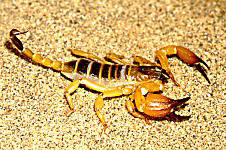|
Genus: Opistophthalmus (burrowing
scorpions)
Life
> Eukaryotes
>
Opisthokonta >
Metazoa
(animals) > Bilateria > Ecdysozoa > Panarthropoda > Tritocerebra >
Arthropoda > Arachnomorpha > Cheliceriformes > Chelicerata > Euchelicerata
> Arachnida > Scorpiones
(scorpions)
> Superfamily: Scorpionoidea > Family: Scorpionidae
This genus is aptly referred to
as the burrowing scorpions as most species do in fact burrow. Some species are psammophilous
with long macrosetae allowing them to negotiate soft sand into which they
burrow. Other species are pelophilous utilizing the
enlarged chelicerae or chelae for digging in hard soil. These burrows are often
constructed with a shallow scrape under rock that leads into the burrow. The
burrows vary from 10 mm to 1 metre deep and may run to a length of 1,5 metres.
Generally burrows in soft sand are longer with shorter burrows in harder soils.
Certain species are scrape dwellers and do not burrow as adults, unlike the
young that do burrow. The males of these scrape dwellers have elongated chelae.
Scrape dwellers and the few species occurring amongst rocks are dorsoventrally
flattened, but not to the extent of Hadogenes.
Opistophthalmus scorpions
are bulky and often with very broad and powerful chelae that holds the prey
firmly, crushing it to death. If the prey is too large, it is stung and held
until it dies. It then orientates the prey and eats it head first. Some species,
and especially the males, that occur under stones, have more elongated chelae.
These scorpions vary a great deal in colour ranging from yellow through brown to
black usually with darker or lighter areas. The leg colour is generally lighter
than the rest of the body. The integument of some scorpions is smooth and shiny
while others are granulated and dull.
When threatened, Opistophthalmus
adopts an aggressive stance, body raised up off the ground and curled upward
with the sting held above the head ready to strike. The pedipalp chelae are held
forward protecting the face. Opistophthalmus readily stridulates by
rubbing its chelicerae together and assuming its aggressive stance and executes
numerous strikes with its sting but as with most harmless snakes is all bluff
and makes for interesting photography. When in the burrow the broad chelae are
effectively used to block the entrance to protect itself against intruders.
Three Opisthophthalmus
species (O. glabrifrons, O. wahlbergii and O. boehmi) are
currently available in the pet trade and this may necessitate their protection
in the future as wild populations decline.
Species indigenous to southern Africa
There are 59 described species in southern Africa
with 17 new
species in preparation for publication. Some of the species are featured below.
|
Opistophthalmus macer
Occurs from
False Bay to Worcester then eastward to Port Elizabeth in the Western and
Eastern Cape. Total length of these scorpions are 115mm including the caudal
segment (tail). |

|
|
Opistophthalmus capensis
Has a distribution extending from St. Helena Bay on
the west coast to Mossel Bay on the south coast of the Western Cape.
|
 |
|
Opistophthalmus adustus
This attractive psammophilous scorpion occurs in the sand dunes of the
southern Namib where it constructs multi-directional borrows up to 750mm
below the surface. |
 |
|
Opistophthalmus pallipes
Reaches 130mm total length
and occurs in the Northern Cape and Western Cape, along the west coast from
Namaqualand to the Cedarberg and Piketberg in the south. This scorpion
constructs shallow burrows in rocky habitats. The male can easily be seperated
from the female with his slender pedipalps. |
 |
Text and images by
Norman Larsen ©. |
